Halo: Reach Hands-On
We spend some quality time with the multiplayer beta of Bungie's next Halo game.
On May 3, owners of Halo 3: ODST will get a chance to participate in the multiplayer beta for Bungie's next big game, Halo: Reach--a game that focuses on events that transpire before those that occur in Halo: Combat Evolved. We had the opportunity to get an early look at the beta to check out some of its features and match types that will be available when it goes live. But one thing we didn't get to experience was the improved matchmaking system that powers the beta (matches were set up manually at the event). "We tried to give players more control over having the best experience possible," says Brian Jarrard, community director at Bungie. "On the matchmaking side, you'll have the ability to toggle different types of criteria that will allow you to find the types of games that are most important to you. You'll be able to decide if connection speed is more important to you than anything else--if you want to find the best game possible. Or perhaps you're more concerned with finding someone that speaks the same language as you."
Why Are Video Game Adaptations Good Now? | Spot On Fallout 4 Next Gen Update Comparison Fallout 4 Steam Deck Verified Gameplay ALIEN: Rogue Incursion - Announcement Teaser Trailer Stellar Blade - 13 Things I Wish I Knew S.T.A.L.K.E.R. 2: Heart of Chornobyl — Official "Not a Paradise" Trailer Manor Lords - Official Medieval City Builder/RTS Launch Trailer Honkai: Star Rail - "Then Wake to Weep" | Version 2.2 Trailer Devil May Cry: Peak Of Combat | Dante: Blazing Tempest Gameplay Trailer SAND LAND — Official Launch Trailer Sea of Thieves Season 12: Official Content Update Video Stellar Blade - Hard Mode No Damage Gigas Boss Gameplay
Please enter your date of birth to view this video
By clicking 'enter', you agree to GameSpot's
Terms of Use and Privacy Policy
Another big change for matchmaking has to do with deciding what kind of matches you want to play. "If you recall in Halo 3, we throw you into a random map and a game type comes up," Jarrard explains. "If you don't like it, the majority can vote to veto that and then you'll get something mysteriously picked from the blue that you may or may not like that might be better or worse than what you just vetoed. In Reach, we're going to be a little more transparent about that. We're going to give people four voting options and you'll be able to pick right from the menu which map and [game] the majority of your group would like to play. So you'll be able to control what you like to play."
After a little more briefing about the matchmaking services, we jumped into some of the finer points of the beta's multiplayer combatants, Elites and Spartans. As you might suspect, the Elites in the Halo: Reach beta are quite formidable--not only are they physically larger than Spartans, but they're also slightly faster and can regenerate health by hiding behind cover. But both sides have access to one very important new feature called armor abilities. These special abilities are built into preset loadouts that you can select from at the beginning of a match or when you respawn. Elites and Spartans have race-specific armor abilities called evade and sprint, respectively. The Elites' evade armor ability functions pretty much as described as it allows them to do a quick tumble to get out of the line of fire or to move in quickly for a melee kill. Conversely, the Spartans' sprint armor ability gives them a quick boost of speed, but they can't fire while sprinting. Both are incredibly useful for getting out of a jam, but it's worth mentioning that all armor abilities can only function for a short amount of time (as indicated by a meter near the armor ability icon) and have a short cooldown period before you can use them again.
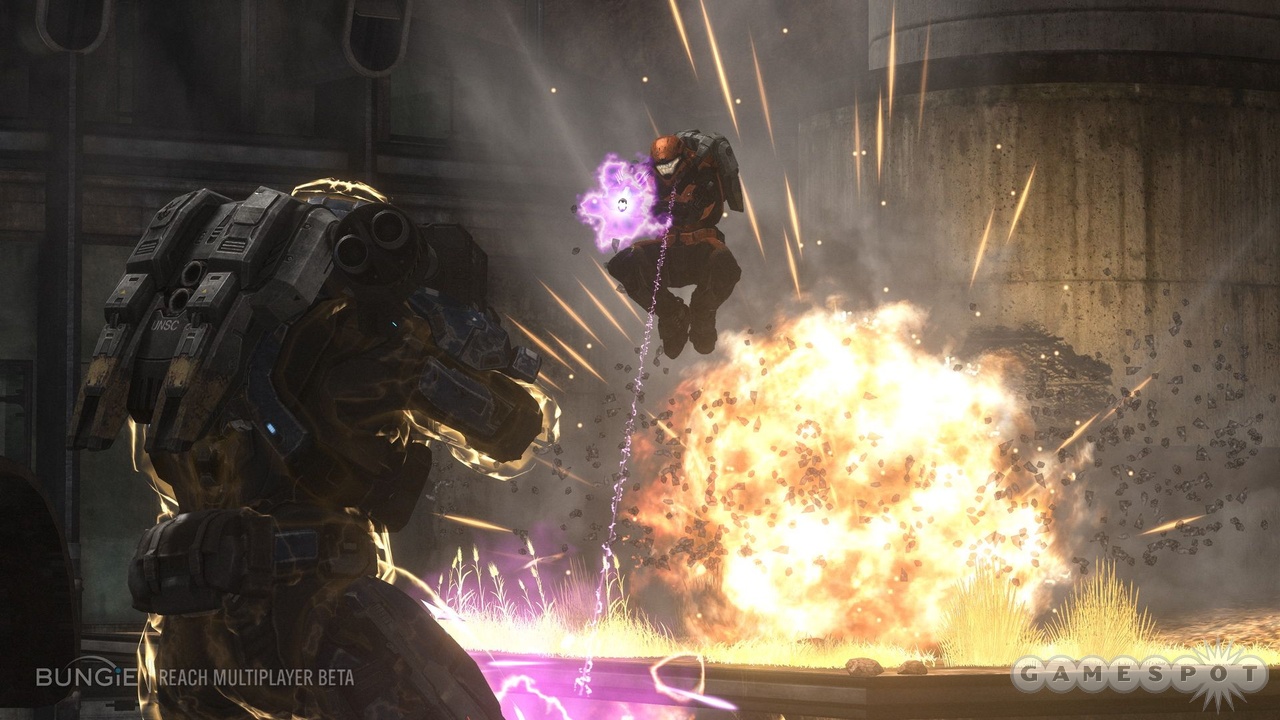
It is especially worthwhile to keep this in mind for the other armor abilities that are available to either side. A particular favorite--and one that changes Halo's gameplay more than any other ability--is the jetpack. For a brief amount of time, you can take to the skies and reign destruction down on those below you. At the same time, however, you can inadvertently make yourself a target for snipers if you try to fly straight up into the air and drain the jetpack high above ground because you'll run the risk of fall damage. We found that the jetpack is best suited as a superjump ability, making quick leaps to ledges and rooftops when the situation calls for it.
Another favorite is the active camo armor ability. This functions much like the active camo power-up found in previous Halo games, only your level of camo corresponds directly to how quickly you're moving. In other words, if you're running like you normally would with active camo turned on, then most of the other players on the map can easily see the distortion it causes on your character. But if you move slowly and stalk other players, it's much easier to remain undetected to eventually move in for an assassination, which pulls the camera out to a third-person perspective so you can get a good look at your character performing a special kill animation. The loadout that includes active camo and swords for Elites can be an incredibly effective combination for these kinds of situations.
The last of the armor abilities--called armor lock--can be useful but takes a little more skill to use effectively than the others. Armor lock makes you a stationary target, but it also grants you temporary invincibility. Of course, if you have three or four enemies firing on you at once, it may not seem all that useful, but the armor lock also charges an EMP blast, so it'll take out the shields of those around you, giving you a small chance to take some opponents down with you.
As previously stated, these armor abilities are all tied to loadouts--weapon and armor ability combinations that you choose when you spawn. The type of loadouts available are determined by the match type, and in some cases, more loadouts become available as you progress through a match. Generally, from what we've seen so far, the armor abilities and the weapons in the loadout generally complement each other, so if you're carrying a heavy weapon, there's a good chance it'll have armor lock to go with it. Bungie says that players can eventually customize their loadouts for custom games as well.
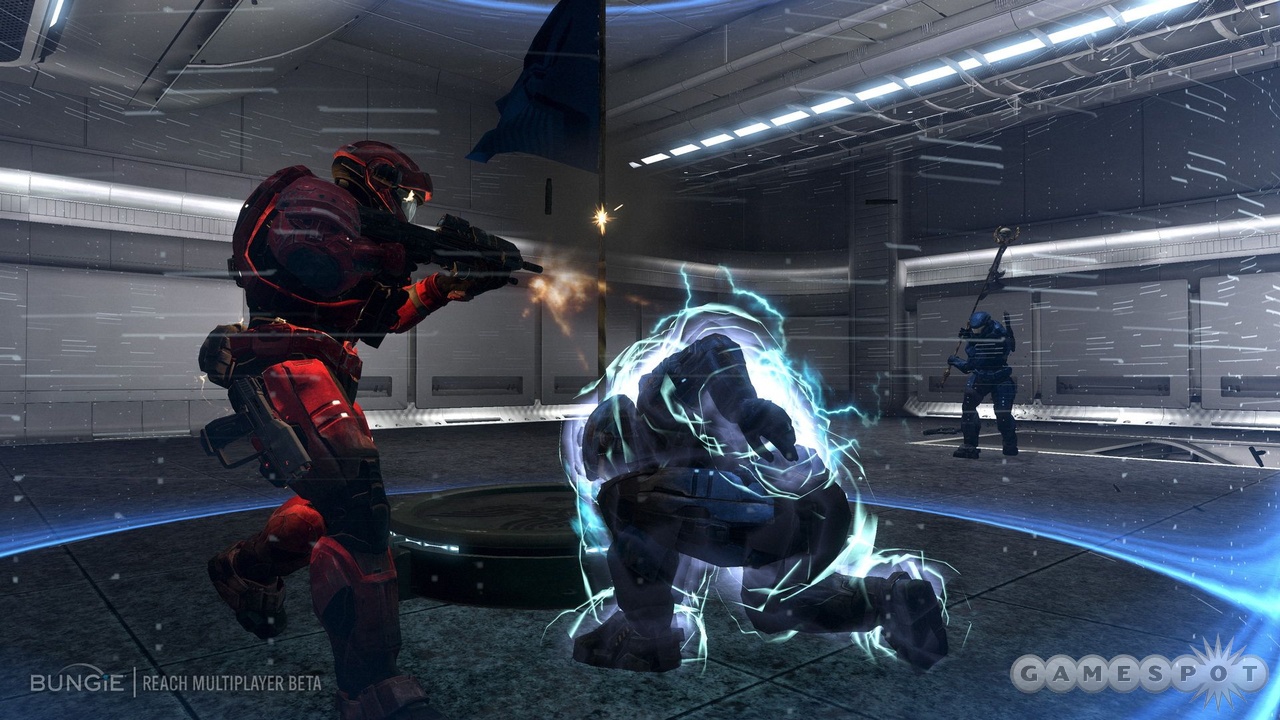
Obviously, having loadouts and picking them in a strategic manner can mean the difference between winning or losing in the match types available in the Reach multiplayer beta. One of the first types we got our hands on was generator defense, a three-on-three match that takes place on the map called Overlook. Like the rest of the maps in the beta, Overlook is also found in Reach's single-player campaign, but it's been changed cosmetically for multiplayer. It's now brighter and features more color, making it a little easier to spot players as they move around the map. But the map itself really isn't that large. There's a small base area located at the top of a hill where the Spartans spawn; the Elites spawn at the bottom of the map and have to cross a small stream to make their way into the central area.
Just outside the Spartan base, in the central area, there are three power generators. The Spartans must defend these generators from the attacking Elites and can do so by either engaging Elites directly or by locking down the generators (by moving up to the generator and pressing X), which makes them invincible for a short amount of time (about 30 seconds). There's a slight cooldown period that exists when the lockdown ends and when a Spartan can reactivate it, but doing so is absolutely the key to success in this match. In fact, our attempt to engage the Elites directly at the beginning of the match only worked for a brief time before they were able to take out one of the generators and then focus their efforts on the remaining two.
Sure, it's not the most glamorous way to get a win, but it works in this scenario. For the Elites, the best way to win seems to be a multipronged attack where one Elite member attacks an unprotected generator, causing a small distraction for the Spartans who will receive a warning signal that a specific generator is being destroyed. Meanwhile, the other Elites can focus their efforts on another generator and try to spread the Spartans' defenses. This map works great with just about all of the armor abilities, but the jetpack proves especially useful because it makes it easier to navigate the terrain and make your way to the generators. If you're not happy with the default weapons in the loadout, new weapons come in via pods that smash into the ground, and they contain some devastating weapons, such as a sniper rifle, rocket launcher, or Spartan laser. At the end of the round, the two teams swap sides--Elites are now Spartans and vice versa.
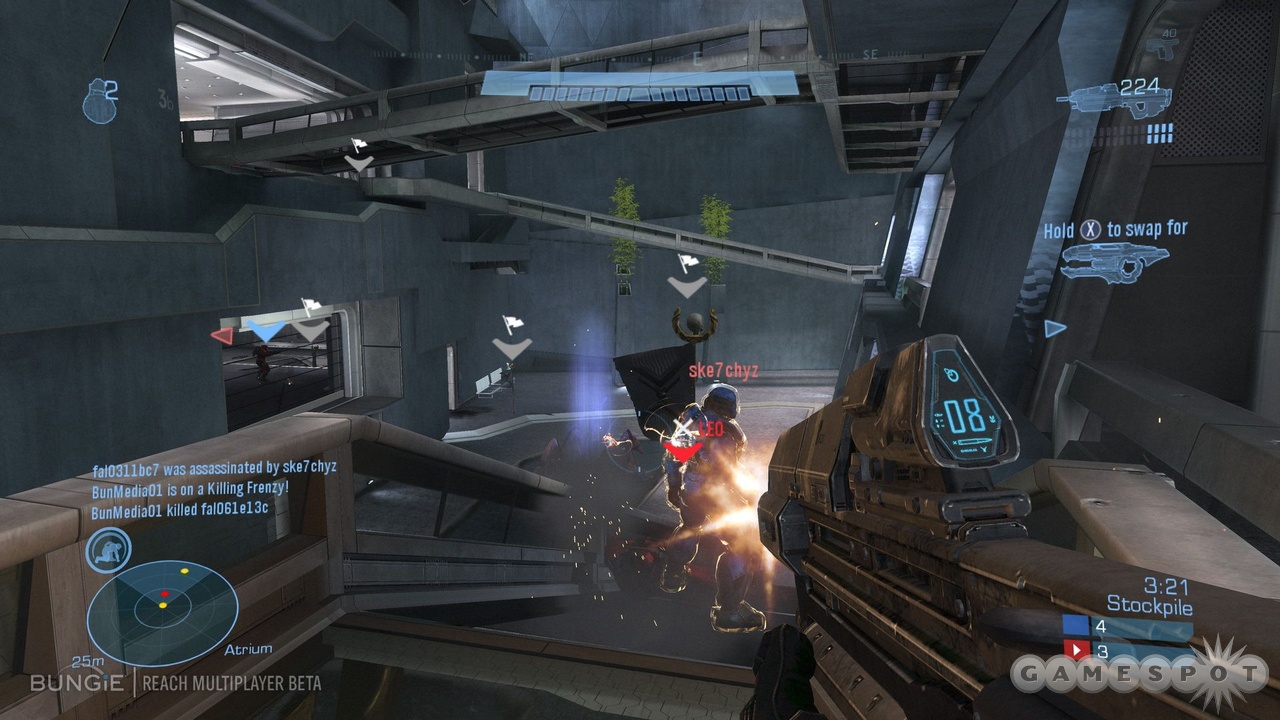
Our next match took us to the stockpile match type on a map called Swordbase, an ONI building also featured in the single-player campaign. Swordbase is an indoor map that features two buildings with interconnected bridges and man cannons in the atrium area. Because the map is designed in a vertical way, you can probably imagine how useful the jetpack armor ability is for leaping back and forth between buildings or bridges, but it's even more useful when the stockpile objective comes into play. Described as "capture the flag on steroids," the stockpile match type plants four flags at random points on the map. Your goal is to take these flags to your designated scoring area, which sounds simple enough, but the catch is that you not only have to take them to your stockpile, but you also have to keep them there until the timer runs down and counts the flags toward your score. This means that players from the other team can hang out near your scoring area (or you can do the same to them) and physically remove the flags.
To say things can get a little chaotic in Swordbase is an understatement. You often have people using the jetpack ability to grab flags and take to the skies. And because there are so many vertical landing points, the people who use it are hard to target. At the same time, there are also plenty of sniper spots, as well as additional interior areas, for players using active camo to hide and strike when an unknowing flag carrier marches through the room. Still, flag carriers aren't completely defenseless. They can use the flag as a melee weapon, but it's often better just to drop the flag entirely and take the chance to win a firefight than it is to make it your primary attack method. Also, it's pretty fun to be a jerk and take flags out of the opposing team's stockpile just before the timer runs out.
For our third match type and map combination, we jumped over to a map called Powerhouse for a game of headhunter. Powerhouse's main area is split in two by a massive stream surrounded by tall concrete barricades. At the top of these barricades, there are a couple of small buildings, one of which is surrounded by a small rock ridgeline area that you can hide behind. The structure of this map seems to push the action in a drainlike direction where most of the firefights occur on the outside, but they slowly work their way into the center where people fall into the stream and continue fighting. As such, headhunter seems like a natural fit for this map because the main goal is to kill opponents and take the flaming skull that pops out of their bodies when they slump to the ground. You can then take the skull to the designated scoring area to get a point for your team.
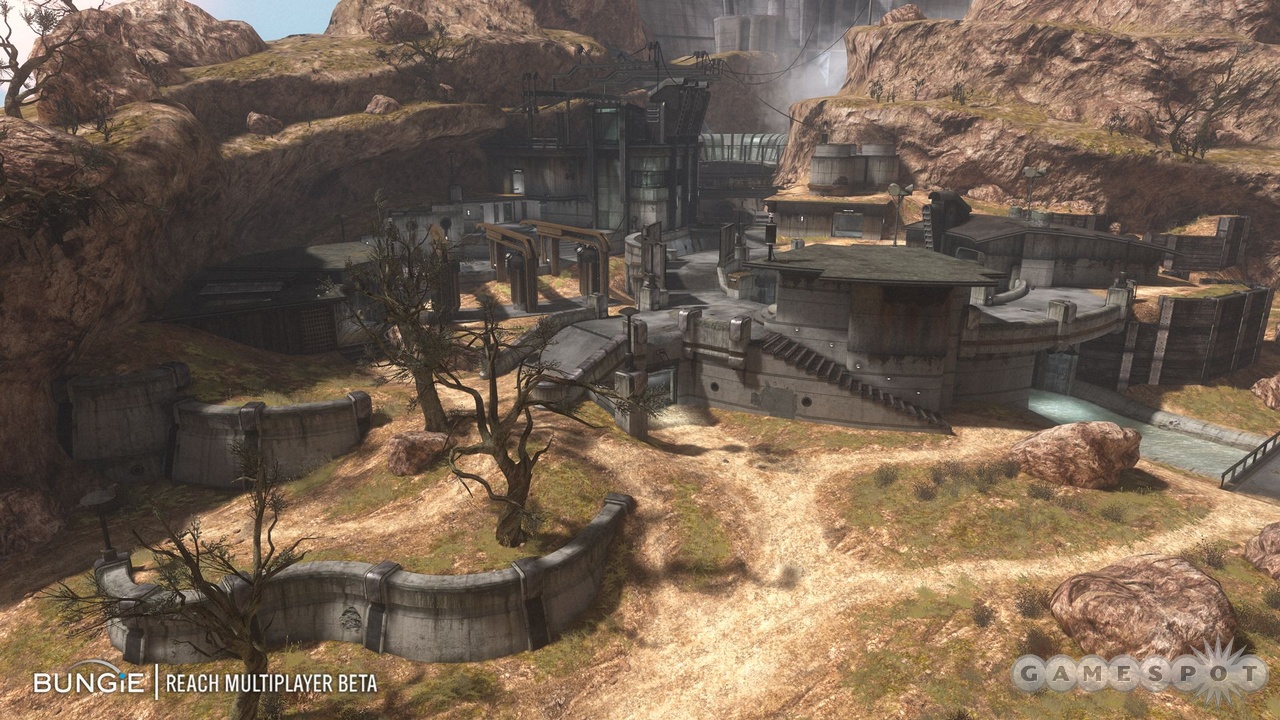
But headhunter gets a little crazier than that. Because you're not really limited to the number of skulls you can carry at a given time, you can try to pick up a few extras before returning to the scoring area. However, you also run the risk of having someone gun you down and take all of the skulls in your possession. There's a real risk-versus-reward incentive at play here, especially if you collect 10 skulls and score them all at once--you can win the match in one fell swoop. Of course, taking down someone with so many skulls just before he or she scores them is rewarding, but other players will immediately flock to them like pigeons to garbage, making it a real challenge to procure that many skulls at once.
If you're looking for something a little less hectic than headhunter or even stockpile, then the invasion six-on-six match type might be more your speed. There's an invasion-specific map in the Reach beta called Boneyard--a UNSC destruction and smelting facility. In fact, the map features a UNSC carrier in the process of being dismantled before its components are taken to the smelter located just beyond it. Still, that might not really convey the size of this map until you learn how invasion factors into it. Essentially, invasion works in three tiers. In the first tier, the Elites have to make their way toward the UNSC ship being guarded by Spartans and infiltrate it. Once inside, the team of Elites has to deactivate a series of laser-guarded doors by taking and holding specific points in the ship. In the second tier, the Elites have to make their way to the smelter (crossing a large open area) and deactivate the barriers guarding a data core. Lastly, the third tier requires the Elites to take the data core and run it to a phantom located near an elevated platform outside the smelting facility. Multiplayer design lead Chris Carney described the structure best as a game of, "territory, territory, and then capture the flag."
The first tier works best with a simple defense strategy for the Spartans. Holding the line in the ship and guarding the two positions that Elites can use to unlock the barrier is far more effective than leaving the ship to engage the Elites outside. In the second tier, vehicles come into play (unfortunately, none of the new vehicles from Reach are available, but there are plenty of old ones to use ranging from warthogs for the Spartans to ghosts for the Elites), which makes it a little harder to defend strategic points from the Elites. As for the third tier, players on both sides have access to more loadouts and more vehicles than they did before (they unlock as the match progresses), so the action gets pretty intense. As mentioned before, this is one mode where it pays to have some strategy for both sides. Elites seem to have more success when they keep a few team members back to snipe Spartans roaming in the large open area, while Spartans can gain the upper hand by using the warthog and later the scorpion tank in an effective manner.
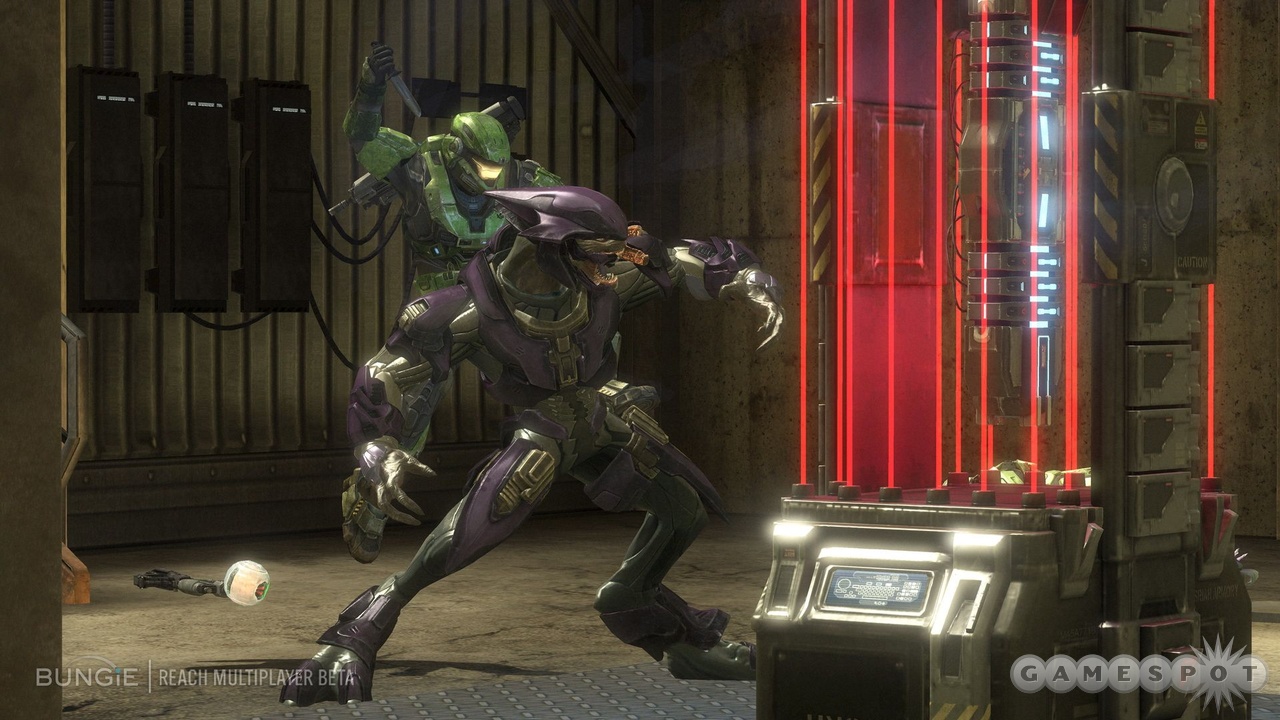
There's so much more to talk about for the Halo: Reach beta, and we haven't even talked about the new weapons. Both Spartans and Elites have their share of new weapons to use in the beta. The Spartans specifically have the designated marksman rifle (a mid- to long-range weapon that replaces Halo 3's battle rifle), as well as the grenade launcher, which has some interesting abilities. In addition to regular fire, grenade launcher's rounds can also be manually exploded by holding down on the right trigger and then releasing it, making it possible to set traps. Meanwhile, the Elites have the Covenant focus rifle (a sniper rifle that launches a continuous stream of damage, but you have to be able to hold it on the opposing player for it to be really effective), a needle rifle (the needles can stick onto a player and eventually explode), a plasma launcher (shoots out multiple rounds at once if you hold the trigger down), and a plasma repeater (a weapon where its rate of fire slows as it overheats, unless you vent it).
Your overall skill with these and the other weapons (which you can view over and over again thanks to the in-game movie recording) in the beta are rewarded with the player investment system. At the end of a match, you're rewarded with credits that you can spend in the armory. Inside this armory, you'll find things like new helmets or armor pieces, but there's also an area to change emblems, emblem color, and the color of your Spartan's armor. The cosmetic changes you make to your character will appear in both multiplayer and single-player modes in Reach, as well as act as a little extra incentive to play through both modes. You can also earn credits by completing daily and weekly challenges designed by Bungie, but you'll have to wait to play these because they won't be available in the beta. The same goes for The Forge option. Bungie confirmed its existence for Halo: Reach but you won't find it in the beta either.
Needless to say, there's a lot to the Halo: Reach beta--and for good reason. Bungie plans to the take the data it gains for the beta and use it to tweak or refine various aspects of the final version of the multiplayer mode before the game's release in the fall. We'll have more coverage on the beta in the coming weeks, including gameplay footage, and hopefully a closer look at the single-player campaign in the next few months.
Got a news tip or want to contact us directly? Email news@gamespot.com
Join the conversation